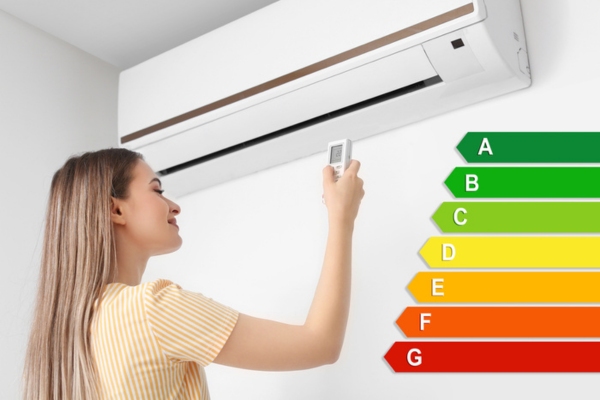Table of Contents
- Understanding SEER Ratings for Air Conditioning Efficiency
- Other Critical Considerations for Selecting the Right HVAC System
- Conclusion
- Contact County Line Fuel for Expert HVAC Services
Choosing the right air conditioner is more than finding the model. It’s also about ensuring optimal energy efficiency and comfort within your home. The Seasonal Energy Efficiency Ratio (SEER) rating is crucial in this decision. It indicates how effectively an air conditioner uses electricity to cool your space.
Recognized standards from the U.S. Energy Information Administration suggest a minimum SEER rating of 14 for residential systems, although requirements vary by state. This article from County Line Fuel will delve deeper into why SEER ratings matter and how they impact your utility bills and indoor environment.
Understanding SEER Ratings for Air Conditioning Efficiency

The SEER rating measures the cooling output of an air conditioning system relative to its energy consumption over a typical cooling season. SEER ratings generally vary between 13 and 21, with higher numbers reflecting greater energy efficiency. This means that an air conditioner with a higher SEER rating requires less energy to provide the same amount of cooling than a system with a lower SEER rating, leading to savings on energy bills and lower environmental impact.
The Significance of SEER Ratings in Air Conditioning

Understanding an air conditioner’s SEER rating before installation is crucial, as it offers multiple advantages. A system with a high SEER rating ensures lower cooling costs by efficiently maintaining the desired temperature with less energy consumption, thereby reducing energy expenses.
Additionally, a properly performing air conditioner, ideally sized for your space like a 4-bedroom home, should be able to reduce temperatures by 10 degrees Fahrenheit within three hours, offering optimal comfort. Moreover, a more efficient air conditioner minimizes environmental impact by emitting fewer greenhouse gasses, making high SEER-rated systems a more eco-friendly choice.
Ready to optimize your home comfort and save on energy bills? Contact County Line Fuel today to learn more about choosing the right HVAC system for your home. Call now!
Identifying the Optimal SEER Rating for Your Home
A SEER rating above 14 is generally considered efficient, but the ideal rating for your home will vary per specific factors such as home size, cooling requirements, and energy usage preferences. Higher SEER ratings denote increased efficiency, leading to better energy savings and performance. However, the effectiveness of an HVAC system is also influenced by the dimensions of your home. For instance, while a 14-SEER unit might be perfect for cooling a two-bedroom house, larger homes, such as those with five bedrooms, might need a system with a higher SEER rating to achieve similar efficiency. Consulting with a professional HVAC contractor helps identify your situation’s most suitable SEER rating.
Calculating Your AC’s SEER Rating
To calculate the SEER rating, divide the annual cooling output by the yearly electric energy input. To calculate this, start by multiplying the air conditioner’s cooling capacity in British Thermal Units per hour (BTU/h) by the total number of hours it runs during a typical day and then by the number of days it operates annually. For example:
A system with a cooling capacity of 4,500 BTU/h operating for 10 hours per day over 150 days will yield 6,750,000 BTUs annually.
If the total electrical energy consumption of the system for the year is 600,000 watt-hours (Wh), the calculation for the SEER rating would be:
SEER = 6,750,000 BTUs/600,000 Wh = 11.25
This formula measures the air conditioner’s efficiency over a typical cooling season.
Locating the SEER Rating on Your Air Conditioner

To comply with U.S. Department of Energy regulations, all HVAC manufacturers must display the SEER rating on their air conditioning units. Models that meet or exceed specific energy efficiency criteria feature the Energy Star label, which signifies superior efficiency. To find the SEER rating of your air conditioner, look for a yellow and black EnergyGuide sticker.
This is typically found on the side of the condenser unit and clearly shows the SEER rating, helping you understand your system’s efficiency. If the SEER rating isn’t readily visible on the condenser unit’s EnergyGuide sticker, another place to check is the air handler unit. If these methods prove unhelpful, you can also identify the SEER rating by searching online.
Gather the manufacturer’s name, model number, and serial number of your HVAC system and use these details to conduct an online search or contact the manufacturer directly. If these steps seem daunting or if you encounter any difficulties, consider enlisting the assistance of a professional HVAC contractor. Although locating the SEER rating is generally straightforward, issues like unclear labeling by the manufacturer can sometimes make it more challenging.
Mismatched Cooling Systems

The condenser unit and air handler must be appropriately matched to ensure your air conditioning system functions at its peak efficiency. Manufacturers design specific air handlers to be compatible only with certain condensers, underscoring the importance of using matched pairs during installation. Unfortunately, mismatches can occur, often due to installations done by inexperienced contractors. A mismatched system may result in reduced efficiency, increased wear and tear, and a higher chance of breakdowns, emphasizing the need for hiring skilled and knowledgeable HVAC professionals for installation tasks.
Don’t let inefficiency drive up your energy bills! Reach out to County Line Fuel for expert advice on selecting an air conditioner with the perfect SEER rating for your home.
The Risks of Improperly Sized Air Conditioning Systems

A crucial aspect of ensuring your air conditioning system is properly matched involves selecting an appropriately sized unit for your home. A mismatched system is about more than incompatible components; it also includes units too large or too small for the space they are meant to cool. An oversized air conditioner short cycle, where the unit turns off and on too quickly to effectively remove humidity or adequately filter the air, causing poor indoor air quality and increased discomfort.
This frequent cycling also consumes more energy, elevating utility bills. Conversely, an undersized system must run longer cycles, straining the unit as it works harder to cool the area. This constant overworking can cause excessive wear and tear and more frequent repairs and may lead to the need for premature system replacement. Homeowners with such systems will likely face high energy costs while struggling to maintain a comfortable home environment.
Preventing Efficiency Loss with Properly Matched HVAC Systems
Even a high SEER rating cannot compensate for the inefficiency caused by a mismatched cooling system. The HVAC system must be installed by someone who fully understands the importance of matching the condenser unit to the air handler and ensuring the system is appropriately sized for your home.
Ready to upgrade to an energy-efficient HVAC system? Reach out to County Line Fuel for expert advice to keep your home cool and comfortable all summer long! Call us today!
Other Critical Considerations for Selecting the Right HVAC System

When choosing the ideal HVAC system for your home, looking beyond just the SEER rating is essential. Several other factors play critical roles in ensuring that you select a system that meets your needs effectively:
- Air Conditioner Size: Oversized and undersized systems can increase energy consumption and reduce comfort. Proper sizing ensures efficient operation and longevity of the system.
- HVAC System Warranty: A comprehensive warranty offers peace of mind by covering repairs or replacements if the system fails to perform as expected. Always check the warranty terms to understand what is included and ensure it offers adequate protection.
- AC Unit Noise: Less efficient Systems often work harder than necessary, which can result in higher noise levels. Opting for a quieter unit can enhance your home environment significantly.
- Air Conditioner System Price: Find a system that fits your budget without compromising quality and efficiency. Plan your finances accordingly to make a cost-effective decision.
When considering these factors along with the SEER rating, you can make a more informed decision that balances efficiency, comfort, cost, and longevity.
Conclusion
Selecting an air conditioning unit with a high SEER rating is fundamental for achieving greater energy efficiency and reducing energy costs. Opting for an ENERGY STAR Certified unit can decrease energy expenses and contribute positively to environmental protection. For expert guidance on selecting the ideal HVAC system and maintaining it efficiently, consult with a professional HVAC contractor. Their expertise can ensure you choose a system that fits your particular needs and helps keep your home comfortable year-round.
Contact County Line Fuel for Expert HVAC Services

County Line Fuel provides top-tier heating and cooling solutions across Clinton, NJ, and the surrounding areas. Our team of professionally certified technicians excels in HVAC tune-ups, repairs, installations, and replacements, ensuring your system operates flawlessly.
We offer the most competitive prices in the region, and our maintenance services enhance comfort and efficiency and help reduce energy costs. Should you need an HVAC repair or consider a system upgrade, we can guide you to the best solutions that fit your budget. A satisfaction guarantee backs all our services. Call County Line Fuel today for a free in-home estimate and to book your next service appointment.
You can click here to contact us now or call us at (908) 735-7610 to find out more!
Related Articles:
